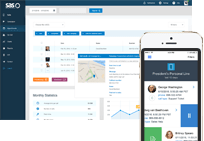- Log In
- Support
- Company
- Contact Us
- Live answers @ 1-888-532-4794
Top 11 Reasons Why Call Centers Have Hold Times
When you make the decision to start using a call center, either 24/7 or just as overflow support, the goal, of course, is that your callers will never experience hold times, or at least significantly less hold times than they experience when your front desk is overwhelmed. The problem is that most consumers have unrealistic expectations about the level of support that call centers can provide. Does the call center have more staff than you do? Yes. Do they have people working around the clock? Yes. But does that mean that hold times are a thing of the past? Realistically, no.
There are a number of reasons why call centers leave callers hanging. While they are not ideal, some can be prevented, and others are just par for the course when it comes to outsourced answering services. To help you have a full understanding of what’s going on behind the scenes, we’ve outlined 11 issues that contribute to longer-than-normal wait times.
#1. The service is understaffed.
If the service has recently lost staff, or if they haven’t been able to hire new agents because of rate of pay (which is notoriously low in the call center industry), then you’re looking at a staffing issue with no immediate resolution. It’s kind of hard to answer the phones promptly when there simply aren’t enough agents to manage call volume. However, it’s important to note that unless calls are coming in on a one-to-one ratio of calls to agents, there will more than likely be some hold time, even if it’s only a few seconds.
When you’re looking at things that are out of the call center’s control, such as illness or weather-related absences, those present their own challenges. If the issue is absence due to illness, shift supervisors may be able to call in staff to cover a few hours here and there. And if the issue is weather, this would be an ideal time to utilize any work-at-home staff that the center has on their payroll to improve the calls-to-agents ratio.
#2. There are unexpected spikes in call volume.
One of the greatest challenges that call centers face is unexpected spikes in call volume, which, by their very nature, cannot be predicted or prepared for. There are times of day where call volume is heaviest –usually from 7am to 10am or 2pm to 5pm – and staff is scheduled accordingly to accommodate that increased traffic. But when there is a sudden influx of calls, such as from a promotion that was not brought to the call center’s attention or a product recall, wait times will be longer than the norm. Because there’s no way to predict the duration of the call volume spike, it would not be advisable to call in staff members who are off. This will impact the center’s bottom line and may prove to be unnecessary by the time the staff arrives.
#3. There are expected spikes in call volume.
Even expected spikes in call volume can be a logistical nightmare. Here’s a for instance. Let’s say that a local retailer is running a radio promotion at 1am on a Sunday, and there is an average of 25,000 listeners during that hour. If the call center knows the date, time, and duration of the ad, they can staff suitably to minimize holds. But what if the number of listeners just happens to be double on that particular date? Not only is this unpredictable, but it is unmanageable. Unless management is psychic, there is no way to forecast or adjust for this type of overflow.
#4. The service inaccurately assessed trends forecasted from the previous year.
Speaking of forecasting, this is something that call centers do, year over year, to gauge the anticipated call volume on any given day. Trends are examined from the previous year, and staff is scheduled based on those numbers. But what if the center’s client roster has increased by 500 over the past year? If the increased call volume is not accounted for in the new forecast, the center may be grossly understaffed, and up goes the queue time. When such a situation is not immediately realized or addressed, it will certainly engender ire in callers and clients alike.
#5. It’s the middle of the night.
Call centers are constantly working to ensure that they have appropriate coverage for peak hours and throughout the day. Where this becomes difficult is in the overnight hours. Agents are generally required to be available for all shifts, depending on scheduling needs. However, as one might imagine, most aren’t chomping at the bit to come in for a 12am to 8am shift. This can result in call-outs that are hard to cover when you’re trying to get ahold of unscheduled staff at 12am. That isn’t the only issue, though.
While call trends are examined in advance for scheduling purposes, there is no good way to gauge how many people will be calling in at 3am. What it all adds up to, unfortunately, is extended wait times, for which there is no rapidly available solution. If it gets really bad, supervisors may have to pitch in and start taking calls.
#6. Some agents are slower than others, especially when they are in training.
As with any new employee starting any new position, training is a requisite part of the gig. Many people might be inclined to believe that answering phones is easy stuff. And in certain cases, that may be true. But when it comes to answering phones at a call center, agents are responsible for way more than simply picking up the phone. First off, there’s an entirely unfamiliar software system that they’ll need to learn. They’ll also receive training on:
- Navigating the different scripts that pop up with each inbound call
- Accessing FAQs
- Visiting external sites
- Handling irritated callers
As you might imagine, these things take time. That being said, there are bound to be minor hiccups when an agent is just starting out, and those hiccups will cause minor delays. The more delays you have in a row, the longer the hold times.
#7. Lines are tied up when both an agent and a supervisor are stuck on an escalation call.
As part of the training process, agents are walked through a number of scenarios, including those where calls must be escalated to a supervisor. More often than not, a skilled agent is able to talk a caller down from a heightened state and complete the call professionally while addressing the caller’s concerns. But there are times when even the best agents struggle and need a lifeline. That is where escalation calls come in. Without arguing, an agent will let the caller know that they will connect them with a supervisor to field their request.
Once the supervisor is on the line, they take over. Yet, that does not mean that the agent is free to take another call. It is the agent’s responsibility to remain on the line silently and listen as the call is brought to a resolution. Then, after the call closes, they have a quick recap with the supervisor about what happened and how to address such issues in the future. Depending on just how upset the caller is, you could wind up with both an agent and supervisor tied up for upwards of 15 to 20 minutes on one call. Naturally, the call queue suffers.
#8. Super lengthy or complex scripts are causing a backlog.
Some scripts are so long and complex that they extend calls based on everything that the agent has to accomplish from start to finish. Call center programmers do work with clients to build clear, concise scripts. However, depending on the industry or call type, that is not always possible. Agents typically receive specialized training on expediting calls when it comes to the most challenging scripts, but that won’t necessarily reduce call duration. If there aren’t many agents working a particular shift, and several calls come in on a tedious account, there is nothing for callers in queue to do but just wait it out.
#9 There is improper call distribution management at the floor level.
Managers on the call center floor are tasked with watching the minute-over-minute and hour-over-hour trends in call volume, and ensuring that there are enough agents available at any given time to handle the traffic. What this might look like is rearranging agents’ breaks slightly to accommodate an influx, changing lunch hours, calling staff to come in a little early for their shifts, or asking staff to stay a little later than scheduled.
If call volume is not being monitored appropriately and adjusted for in real time, this can present a problem. In the best-case scenario, managers are on top of things, and agents are shuffled as needed. In the worst-case scenario, even with expert monitoring and organization, call spikes can’t be completely ameliorated with scheduling modifications. The result? Long holds.
#10. Calls are stalled in the ACD system.
ACD systems, aka automatic call distributors, are used by call centers to distribute inbound calls evenly based on the number of agents that are currently available, or based on other factors, such as skills-based routing. Calls are held in a queue and dropped to the appropriate agent immediately following their previous call. Ninety-nine percent of the time, ACDs work like a charm. However, like practically any other piece of software on the planet, they may be inclined to produce random “glitches.”
In such cases, it may be that a call hangs out in queue and never actually reaches an agent. Eventually, the caller will realize that they’re going nowhere fast, and they’ll hang up. This will quickly resolve the problem. But there’s no way to account for this type of spontaneous occurrence. And thus, there’s no way to correct the hold time it will create for that one in a thousand unlucky caller.
#11. The service is suspended or interrupted due to inclement weather.
Although a rare occurrence, inclement weather can cause a complete breakdown in a center’s ability to assist their clients. Even with power backup and network redundancies to account for natural disasters and other untimely visits from Mother Nature, there isn’t always a failsafe. For example, during a recent hurricane, a call center in a directly-impacted area was damaged to the point of being out of service for several days. While their local clients might have anticipated such an issue, their national clients were left high and dry. Certainly, clients are always informed of minor or major service interruptions as soon as humanly possible. But given delays in sending out service announcements, coupled with delays in clients receiving and acting on those announcements by unforwarding their phones, there are bound to be a string of callers who receive the dreaded “this line is not in service” message.
For those who aren’t currently working with a call center, the list above will serve as a heads up of the snags that your customers may encounter when trying to reach you. And for those who can’t go a day without your call center, now you’ll know what could be happening when hold times hit. The good news is that none of these are the norm. If they were, call centers would not be in business.
A call center’s success is dependent upon limiting or eliminating hold times and providing the most professional experience possible for your customers. When a long call queue is brought to your attention, feel free to reach out to your customer service team to pinpoint the source of the problem. They’ll not only get to the bottom of it for you, but they will do everything in their power to secure a prompt resolution, whenever possible.
Categories
- Advice (32)
- Answering Service 101 (18)
- Best Practices (10)
- Call Center Jobs (6)
- Call Center Software (20)
- Comparison (2)
- Customer Service (30)
- Funny (31)
- Holidays (19)
- Industry Hacks (19)
- Infographics (53)
- International (1)
- Medical (8)
- News (12)
- Phone Etiquette (2)
- Phones (14)
- Pricing (8)
- Quizzes (3)
- Receptionist (11)
- SAS Products (29)
- Scripting (4)
- Services (5)
- Small Business (25)
- Starting Up (7)
- Tips and Tricks (19)
- Uncategorized (1)
- Videos (19)
- Workplace (6)
Recently writen
- Call Center Script Best Practices: Advanced Script Block Tips to Optimize Your Answering Service
- January 2025 Release Notes – Adjustments to Call Details Timeline, New Scripting Updates, Live Transcription, and more!
- April 2024 Release Notes – Voicemail Greetings, Ability to Access Websites With a Username and Password, and more!
- March 2024 Release Notes – New Add-On, Settings Revamp, and more!
Follow Us
How about a demo?
We'll show you how our web portal works and answer any questions you have about SAS.
Schedule a demo







